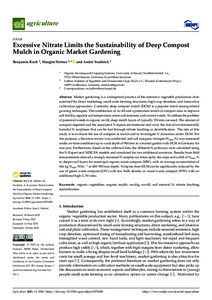| dc.date.accessioned | 2023-06-19T10:17:48Z | |
| dc.date.available | 2023-06-19T10:17:48Z | |
| dc.date.issued | 2023-05-18 | |
| dc.identifier | doi:10.17170/kobra-202306198256 | ger |
| dc.identifier.uri | http://hdl.handle.net/123456789/14839 | |
| dc.description.sponsorship | Gefördert durch den Publikationsfonds der Universität Kassel | ger |
| dc.language.iso | eng | ger |
| dc.rights | Namensnennung 4.0 International | * |
| dc.rights.uri | http://creativecommons.org/licenses/by/4.0/ | * |
| dc.subject | organic vegetables | ger |
| dc.subject | organic mulch | ger |
| dc.subject | no-dig | ger |
| dc.subject | no-till | ger |
| dc.subject | soil mineral N | ger |
| dc.subject | nitrate leaching | ger |
| dc.subject | denitrification | ger |
| dc.subject.ddc | 570 | ger |
| dc.subject.ddc | 630 | ger |
| dc.title | Excessive Nitrate Limits the Sustainability of Deep Compost Mulch in Organic Market Gardening | ger |
| dc.type | Aufsatz | ger |
| dcterms.abstract | Market gardening is a widespread practice of bio-intensive vegetable production characterized by direct marketing, small-scale farming structures, high crop densities, and innovative cultivation approaches. Currently, deep compost mulch (DCM) is a popular trend among related growing techniques. The combination of no-till and a permanent mulch of compost aims to improve soil fertility, regulate soil temperature, retain soil moisture, and control weeds. To address the problem of perennial weeds in organic no-till, deep mulch layers of typically 150 mm are used. The amount of compost required and the associated N inputs are immense and carry the risk of environmentally harmful N surpluses that can be lost through nitrate leaching or denitrification. The aim of this study is to evaluate the use of compost as mulch and to investigate N dynamics under DCM. For this purpose, a literature review was conducted, and soil inorganic nitrogen (Nmin-N) was measured under on-farm conditions up to a soil depth of 900 mm in a market garden with DCM in Germany for one year. Furthermore, based on the collected data, the different N pathways were calculated using the N-Expert and NDICEA models and simulated for two additional scenarios. Results from field measurements showed a strongly increased N-surplus not taken up by the crops and a shift of Nmin-N to deeper soil layers for municipal organic waste compost (MW), with an average accumulation of 466 kg Nmin-N ha-¹ at 600–900 mm depth. N inputs from DCM can be significantly reduced by the use of green waste compost (GW) with low bulk density or wood waste compost (WW) with an additional high C/N ratio. | ger |
| dcterms.accessRights | open access | ger |
| dcterms.creator | Ruch, Benjamin | |
| dcterms.creator | Hefner, Margita | |
| dcterms.creator | Sradnick, André | |
| dcterms.extent | 13 Seiten | |
| dc.relation.doi | doi:10.3390/agriculture13051080 | |
| dc.subject.swd | Mulch | ger |
| dc.subject.swd | Nachhaltigkeit | ger |
| dc.subject.swd | Biologische Landwirtschaft | ger |
| dc.subject.swd | Direktsaat | ger |
| dc.subject.swd | Denitrifikation | ger |
| dc.type.version | publishedVersion | ger |
| dcterms.source.identifier | eissn:2077-0472 | ger |
| dcterms.source.issue | Issue 5 | ger |
| dcterms.source.journal | Agriculture | ger |
| dcterms.source.volume | Volume 13 | ger |
| kup.iskup | false | ger |
| dcterms.source.articlenumber | 1080 | |


